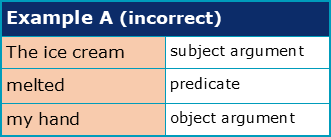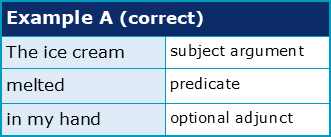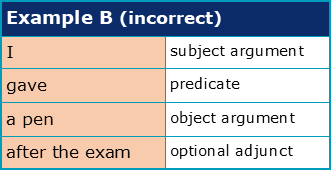What is a verb argument: transitivity vs. valency?

This is the first of three chapters about Verb Transitivity. To complete this reader, read each chapter carefully and then unlock and complete our materials to check your understanding.
– Discuss the importance of verb transitivity
– Explore the difference between arguments and adjuncts
– Introduce the terms valency and transitivity and discuss how they relate to improving grammar accuracy
Before you begin reading...
-
video and audio texts
-
knowledge checks and quizzes
-
skills practices, tasks and assignments
Chapter 1
Of all the eight word classes, verbs are probably the most challenging to master – particularly for non-native speakers of English. Not only do verbs and verb phrases determine the tense, aspect, and modality of a proposition, but they must also be correctly conjugated to show subject-verb agreement for person and number. With bare forms, infinitives, participles and gerunds to consider and perfect, it’s no wonder that students find it difficult to speak and write verbs correctly in academic contexts. A verb’s syntax (how a verb interacts with its subjects and objects) is one area in which it’s particularly easy for students to make errors.
Although Academic Marker has a particular focus on academic contexts, this short three-chapter reader aims to introduce to anyone studying the English language the complexities of verb transitivity. Chapter 1 explores what a verb argument is and explains how the terms ‘transitivity’ and ‘valency’ differ – and why knowing the differences is useful. Chapter 2 then outlines in more detail the structures and rules of intransitive, monotransitive, ditransitive and tritransitive verb types, providing academic phrases that contextualise these verbs for the learner’s reference. Finally, Chapter 3 focuses specifically on the valency patterns of the 150 most common academic verbs so that students can use these more confidently in their own writing.
Why does a verb’s transitivity matter?
Before exploring precisely what a transitive verb is, let’s take a look at the two incorrectly formed sentences below in which the verbs have been marked in bold:


What you should notice in these two examples is that much of the meaning of these expressions is unclear or illogical. Example (a) is confusing because an ice cream is generally unable to melt a hand – that is unless it were made of acid! In (b), the expression ‘I gave a pen after the exam’ is also incomplete for the reader as it leaves you thinking ‘but who did you give it to?’. The reason that both of these expressions are somewhat confusing is because they both have errors with verb transitivity.
Let’s now take a look at same expressions but corrected:


Example (a) is now much clearer because the object argument ‘my hand’ has been replaced with the optional adjunct ‘in my hand’, clarifying that it is the ice cream and not the hand that has melted. Conversely, by simply adding an argument to example (b) via the indirect object ‘James’, the meaning of this expression has also become much more logical. Clearly then, different verbs require a different number of arguments to be considered grammatical, which is precisely how verb transitivity is measured. Small transitivity errors such as those in our previous examples clearly demonstrate then the potential for large errors in meaning.
What are verb arguments and adjuncts?
To more clearly explain why the first two examples were ungrammatical, we need to first understand the basics of verb arguments and adjuncts. A simple syntactic analysis of a clause usually separates clause elements into three primary distinctions: the predicate, the predicate’s required arguments and the optional adjuncts. The predicate is the core verb phrase of the clause, the arguments are the subjects or objects that the main verb requires to be grammatical, and the adjuncts are the optional elements of the clause that add additional meaning.

Let’s deconstruct our first example to see this more clearly:


In this example, the verb ‘melt’ is paired with the subject ‘ice cream’. Semantically, an ice cream can be melted by heat but it cannot physically melt something itself, not like a fire could (as in ‘the fire melted the ice cream’). When the subject argument is an ice cream, the verb ‘melt’ is therefore unable to take object arguments without becoming ungrammatical. Verbs such as ‘melt’ that cannot take objects in this way are called intransitive verbs.
The arguments of a verb then are the subjects, direct objects, indirect objects or oblique objects that are necessary to create grammatical predicates (verb phrases). As there are four possible arguments, there are also four possible types of verb depending on how many arguments they grammatically take. As the following diagrams show, these four types are called intransitive, monotransitive, ditransitive and tritransitive verbs:




Looking at these four diagrams, we can see that the verb ‘give’ that was used in example (b) is a ditransitive verb. Knowing that ditransitive verbs require one subject argument and two object arguments to be grammatical, the examples below highlight that our incorrect expression was incorrect precisely because the verb ‘give’ was missing one of its object argument ‘James’:


How is transitivity and valency different?
When discussing the aspects of a verb’s argumentation and its syntax, it’s common to see the terms ‘transitivity’ and ‘valency’ being used by grammarians and teachers alike – perhaps even being confused from time to time. While these terms are very similar, they are not exactly the same. In short, the transitivity of a verb describes only whether or not that verb takes a direct object argument, and as such verbs can be either classified as intransitive or transitive. Valency, however, describes all the arguments of a verb, and as such includes the four distinctions intransitive, monotransitive, ditransitive and tritransitive. However, so long as you or your students understand that both transitivity and valency describe the grammatical arguments of a verb, there should be little room for confusion.
Now that you have an understanding of what verb arguments are and have explored the concepts of transitivity and valency, our next chapter on this topic focuses more carefully on the differences between academic intransitive and transitive verbs.
Downloadables
Once you’ve completed all three chapters about verb transitivity, you might also wish to download our beginner, intermediate and advanced worksheets to test your progress or print for your students. These professional PDF worksheets can be easily accessed for only a few Academic Marks.
Collect Academic Marks
-
100 Marks for joining
-
25 Marks for daily e-learning
-
100-200 for feedback/testimonials
-
100-500 for referring your colleages/friends